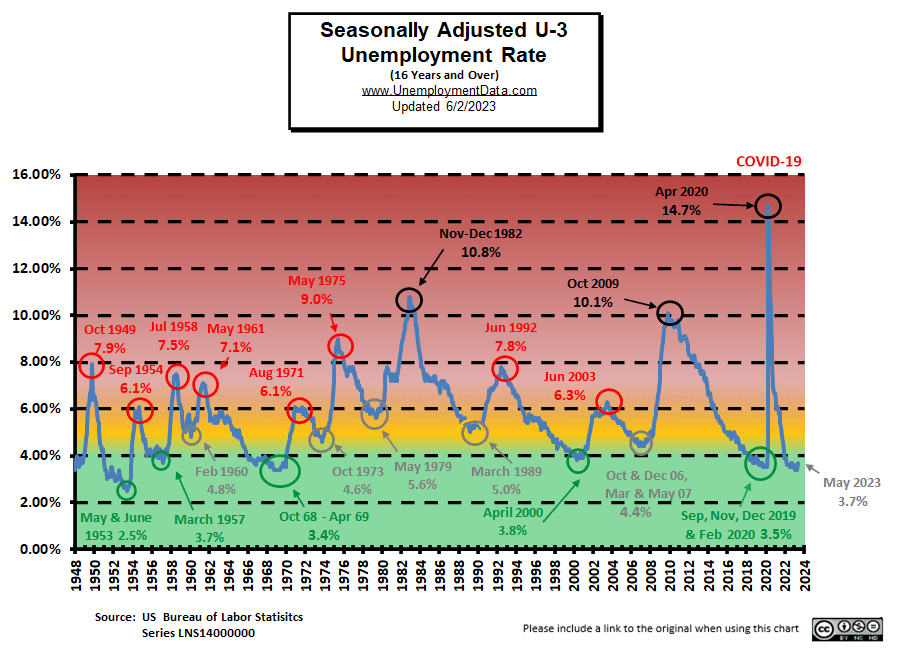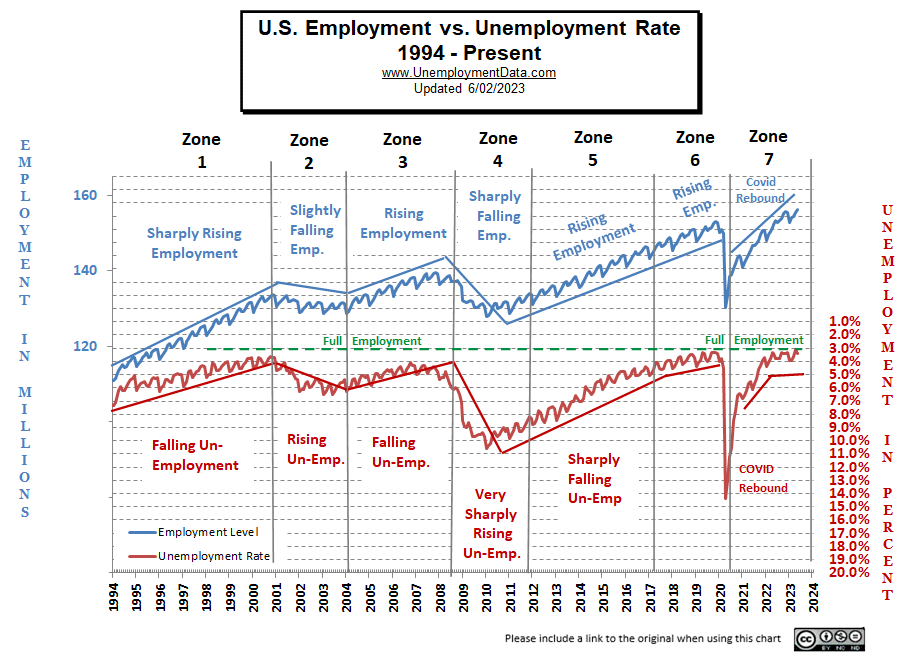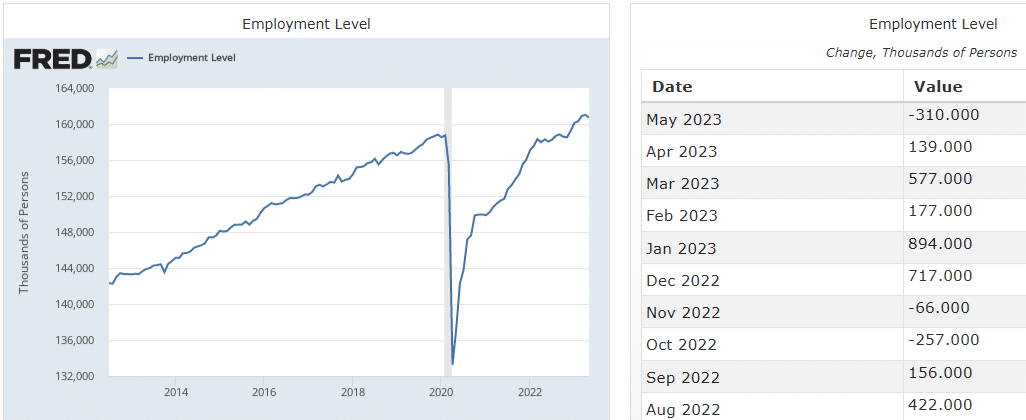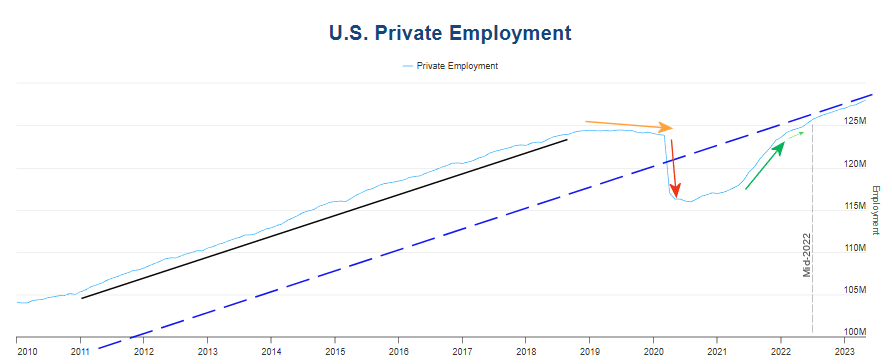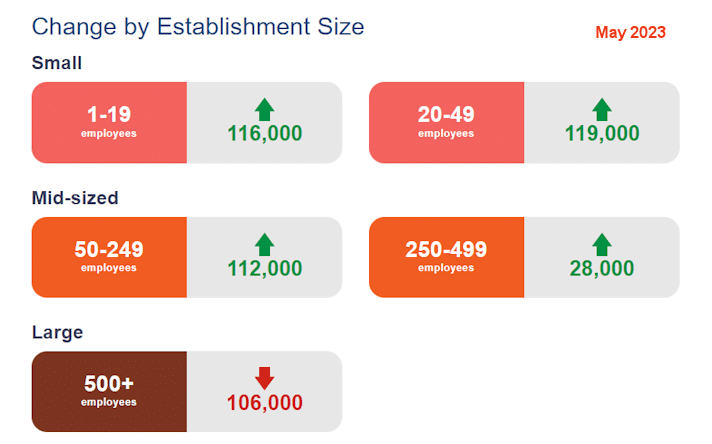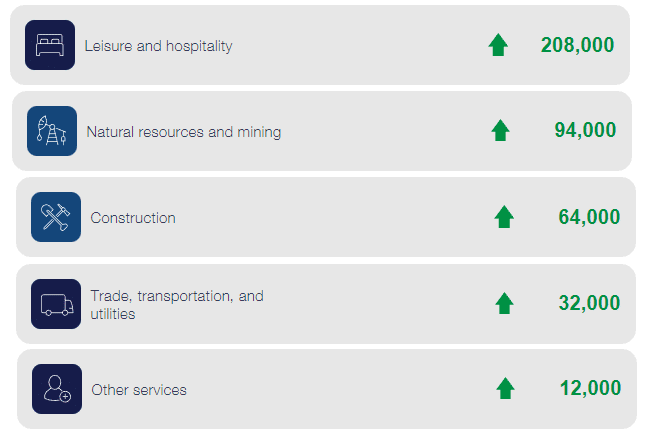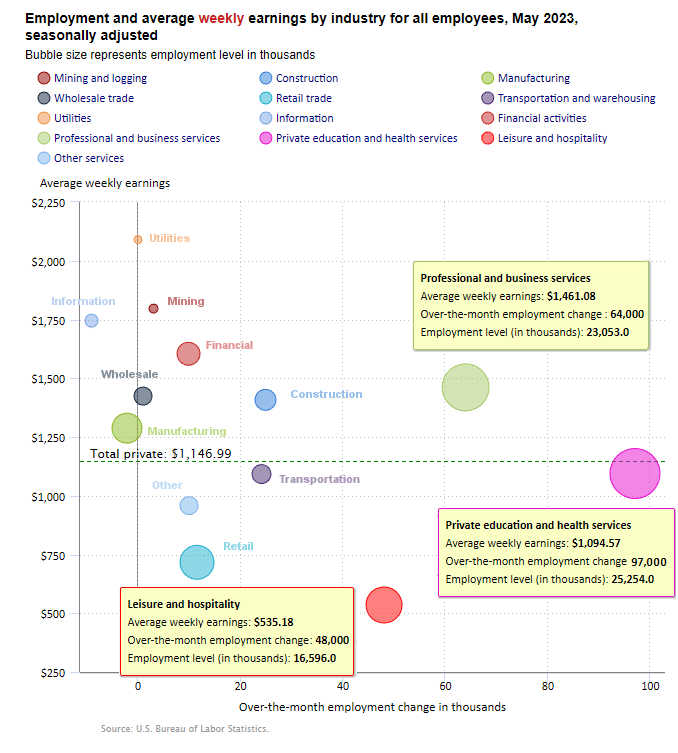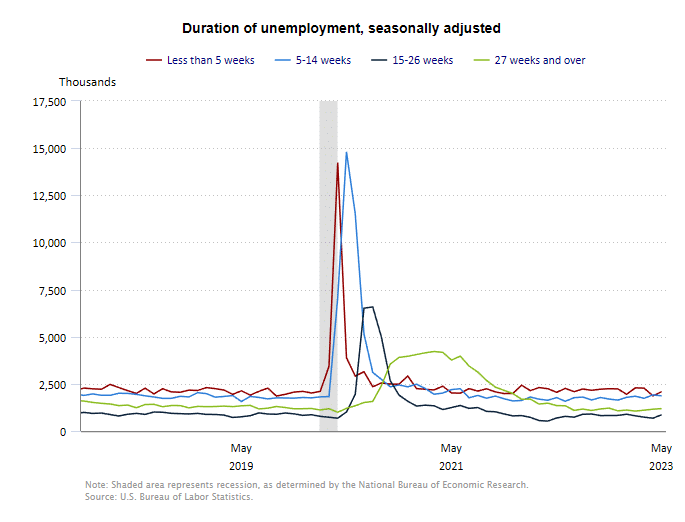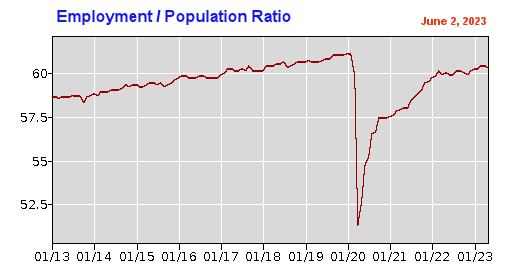The U.S. Bureau of Labor Statistics (BLS) released its employment / unemployment report for May on June 2nd 2023.
Unemployment up Slightly
- Adjusted U-3 was 3.7% up from 3.4%
- Unadjusted U-3 was 3.4% up from 3.1%
- Unadjusted U-6 was 6.4% Up from 6.1%
- Labor Force Participation unchanged at 62.6%
- Unadjusted Employment rose from 155.386 to 156.303 million
According to the Commissioner of the U.S. Bureau of Labor Statistics:
“Total nonfarm payroll employment increased by 339,000 in May, and the unemployment rate rose by 0.3 percentage point to 3.7 percent, the U.S. Bureau of Labor Statistics reported today.
Job gains occurred in professional and business services, government, health care, construction, transportation and warehousing, and social assistance.”
You can read the full BLS report here.
As usual, they are talking about “Seasonally Adjusted Jobs”.
Looking at the Establishment Survey report, we see…
Originally the BLS reported employment of 155.337 million for April which they adjusted to 155.386 million. So they added 49,000 jobs for April. They are reporting 156.306 million jobs for May which is actually an increase of 969,000 jobs based on their original estimates or an increase of 920,000 based on their updated numbers.
Current Employment Rate Chart
Adjusted Unemployment is slightly above the pre-COVID 2019 cyclical lows of 3.5%. We’ve been saying that “typically, March or April has one of the lowest unemployment rates for the year, so we could see a slight increase from here without an actual deterioration of the labor market.” And that is precisely what is happening. Current levels are within the “Green Zone”.
Full Employment?
Last month we said, “Full Employment is when everyone who wants a job has one. It is generally considered to be slightly above 3%. Although, other factors, such as unemployment benefits, can shift the level higher or lower. So, if unemployment benefits are extended from 6 months to 1 year, people will tend to stay unemployed longer, thus raising the unemployment rate.”
After the unemployment rate almost touched the magic full employment line last month, it moved away this month (higher unemployment).
Note: The Unemployment rate is inverted to track the employment rate, neither is Seasonally Adjusted.
Full employment is not considered to be at zero percent because even when employers are having difficulty finding employees, some people are still unemployed due to either structural unemployment (mismatch between worker skills and job requirements, i.e., not enough training) or simply because they quit their job knowing it would be easy to find another (hopefully better) job. Often referred to as frictional unemployment (there will always be people who have quit or have lost a seasonal job and are in the process of getting a new job). See: Highly Skilled Worker Shortage in a Recession?
If the unemployment rate stays constant, but more people are working, where are these extra workers coming from?
Somehow the workforce has to be growing to accommodate these newly created jobs. They could be long-term unemployed (no longer counted in the workforce) returning to the workforce, they could be immigrants entering the workforce, or possibly retired people coming out of retirement because of an offer too good to turn down. This is generally facilitated by rising wages, but this month’s ADP report indicates that wage growth has slowed, possibly indicating that we are nearing the end of this boom.
Current Employment Rate
Despite the fact that both the unadjusted unemployment and the Seasonally adjusted Unemployment rates were up, there were actually almost a million more people working in May than in April. Total Employed went up from 155.386 million in April to 156.303 million in May.
Employment 4.015 million Above Year-Ago Levels
and 5.338 million above February 2020 (prior to the Covid Crash)
Alternative Employment Numbers
As mentioned above, the Bureau of Labor Services actually has two different sets of Employment numbers, the Current Employment Statistics program and another from the Current Population Survey. But there are other sources of data. The FED provides this source and for May 2023 they show a decrease of -310,000 jobs despite the fact that they state the numbers come from the BLS which says employment increased by 339,000. Although, with a rising unemployment rate a decline in the number of jobs makes more sense.
ADP® National Employment Report
ADP provides payroll services for companies nationwide. And years ago, they discovered that they could aggregate the data and develop a database of employment numbers. Many believe that because these numbers are based on actual payrolls, they are more accurate than the BLS numbers. But ADP can only track “private employment,” so it excludes governmental employees.
According to ADP®, private employment was up in May, agreeing fairly closely with the BLS.
ADP: Private employers added 278,000 jobs in May.
- Job growth is strong while pay growth continues to slow. But gains in private employment were fragmented last month, with leisure and hospitality, natural resources, and construction taking the lead. Manufacturing and finance lost jobs.
Ms. Richardson is saying that although employers are still hiring, upward pressure on salaries is easing.
I’ve added a few lines and arrows to the ADP employment chart. The slope of the solid black line represents the rate of increase in jobs from 2011 through mid-2018. Then the rate of increase dropped off and total employment slightly decreased (yellow arrow). The red arrow is the COVID crash in employment. Then the dark green arrow shows the rapid recovery of jobs with the light green arrow bringing employment back to pre-COVID levels. The Blue dotted line has the identical slope as the black line. So, we can see that since mid-2022 employment has been on the exact same trajectory as it was from 2011 to 2018.
ADP Private Employment by Firm Size
ADP also lists increases by “firm size”.
This month, all size companies added employees.
May ADP Changes:
As far as the industry sectors are concerned, in April there were only three sectors that lost employees while May had five. Leisure and hospitality was still the biggest gainer followed surprisingly by Mining.
ADP Also Tracks Salary Changes:
As you would expect in a tight labor market, “Job Changers” saw a much greater increase in salary than those who stayed in their job, as companies needed to offer significant increases in order to attract new employees, but the benefit of changing jobs continues to decrease.
Source: ADP® Pay Insights
May 2023 Employment by Sector
The employment “bubble chart” is a quick and easy way to see how each sector performs on a seasonally adjusted basis. The Bubble’s Size tells us the total Employment for that industry (i.e., larger bubbles mean more people are employed in that sector).
The bubble’s location on the chart tells us that there has been a change in Employment Levels over the most recent month… A bubble further to the right indicates larger job growth. A bubble’s vertical location on the chart shows the average industry salary.
Remember, these are Seasonally Adjusted Numbers, so they aren’t cumulative!
The biggest gainers were Education and health services, followed by Professional Services, and Leisure and Hospitality. Average weekly wages saw a slight decline in May.
BLS Average Weekly Wages
| Date | Average Weekly Wage |
| May 2023 | $1146.99 |
| April 2023 | $1,147.58 |
| March 2023 | $1,141.34 |
| February 2023 | $1,141.61 |
| January 2023 | $1,146.14 |
| December 2022 | $1,125.73 |
| November 2022 | $1,129.01 |
| October 2022 | $1,124.01 |
| September 2022 | $1,119.87 |
| August 2022 | $1,116.42 |
| July 2022 | $1,116.54 |
| June 2022 | $1,106.76 |
| May 2022 | $1,105.47 |
| April 2022 | $1,102.01 |
| December 2021 | $1,086.46 |
BLS Employment and Average Weekly Earnings by Industry
May 2023, Seasonally Adjusted Employment
We’ve added another column to the table below showing the employment levels the BLS reported the previous month. Note that due to “seasonal adjusting,” although they may claim that there was a “monthly increase” (or decrease), there isn’t always an actual increase; you can’t just subtract last month’s “employment level” from this month’s level. For instance, Manufacturing was supposed to have 12,991,000 employees in April and have a -2,000 “decrease”, but in May, there were 12,984,000 employed. That looks like a -13,000 “decrease” to me. And Wholesale trade went from 6,043,200 to 6,051,400 for a seasonally adjusted 1,100 increase, but it seems like an 8,200 increase to me.
| Industry | May Monthly Increase | May Ave. Weekly Earnings | May Employment Level | April Employment Level |
| Total Private Employment | 283,000 | $1,146.99 | 133,443 | 133,103 |
| Mining and Logging | 3,000 | $1,796.45 | 643,000 | 642,000 |
| Construction | 25,000 | $1,408.05 | 7,928,000 | 7,903,000 |
| Manufacturing | -2,000 | $1,287.61 | 12,984,000 | 12,991,000 |
| Wholesale trade | 1,100 | $1,424.13 | 6,051,400 | 6,043,200 |
| Retail trade | 11,600 | $716.70 | 15,550,800 | 15,536,300 |
| Transportation and Warehousing | 24,200 | $1,092.17 | 6,763,000 | 6,743,300 |
| Utilities | 100 | $2,089.92 | 555,900 | 555,300 |
| Information | -9,000 | $1,745.28 | 3,084,000 | 3,096,000 |
| Financial Activities | 10,000 | $1,604.25 | 9,130,000 | 9,122,000 |
| Professional and Business Services | 64,000 | $1,461.08 | 23,053,000 | 22,945,000 |
| Private Education and Health Services | 97,000 | $1,094.57 | 25,254,000 | 25,139,000 |
| Leisure and Hospitality | 48,000 | $535.18 | 16,596,000 | 16,543,000 |
| Other Services | 10,000 | $958.02 | 5,850,000 | 5,844,000 |
Source: BLS
Note: As usual, ADP has an entirely different picture. See Above.
Unemployment
May’s Seasonally Adjusted Unemployment is 3.7%, up from 3.4% in April.
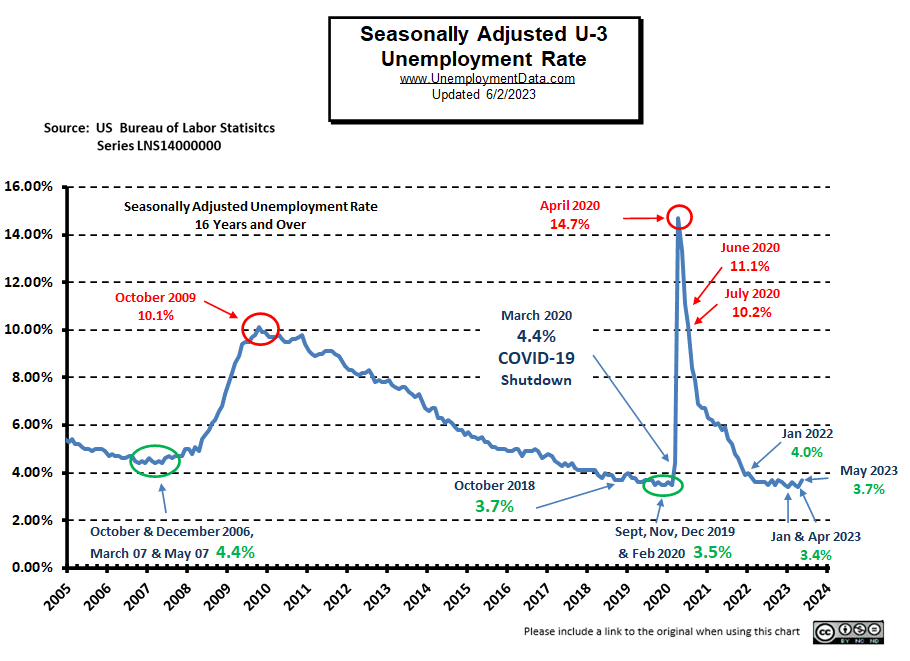
May 2023 Labor Force Participation Rate
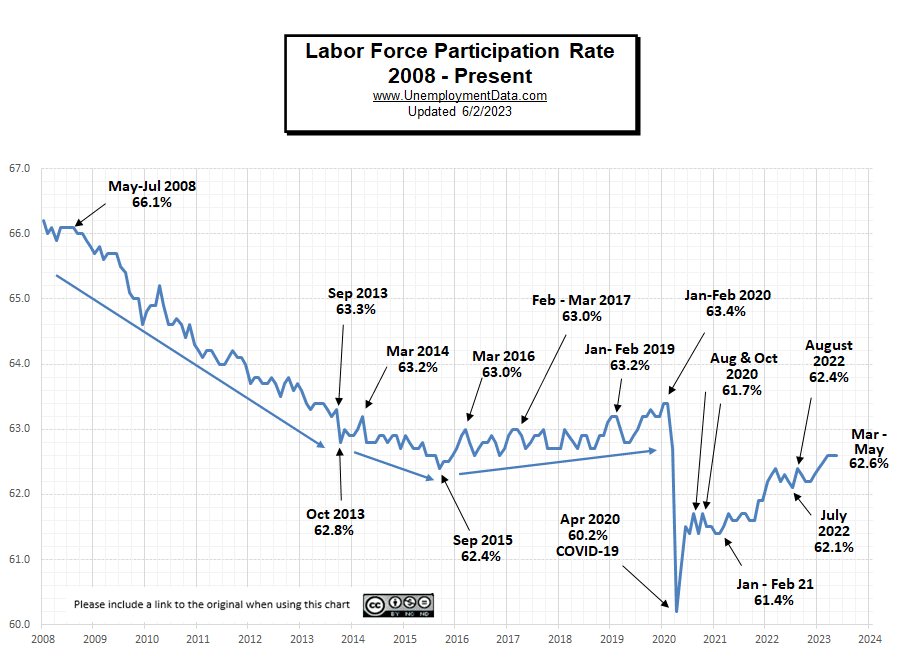
Seasonally Adjusted U1 through U6 Unemployment Rates

Seasonally Adjusted Unemployment by Education
For the second month in a row unemployment by the uneducated rose significantly, which could signal the beginning of a tightening labor market.
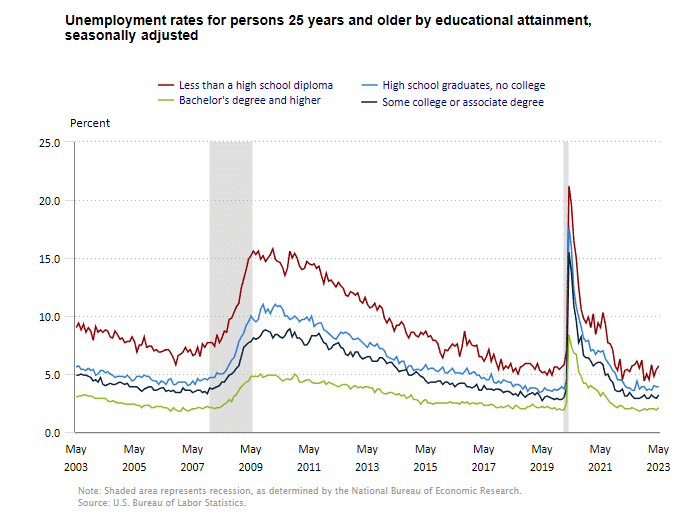
Duration of Unemployment
Long-term unemployment (over 27 weeks) remains low but 15-26 week unemployment has ticked up.
Employment-Population Ratio
The Employment / Population ratio fell from April’s 60.4% of the population employed to 60.3% in May.
See Employment Population Ratio for more information
Read more on UnemploymentData.com.
- Work Injury? Short-Term Income Options While You Mend
- April Employment Nears All-Time Highs
- 5 Must-Know Tips for Optimizing Your Job Search
- Why Becoming a Flooring Installer is a Stable Career Path
- Strategies for Conquering Job Search Frustration
From InflationData.com
- Is There an Optimum Growth Rate of Money?
- Annual Inflation Virtually Unchanged in April
- Can the Dollar Retain Its Ultimate Currency Status?”
- What are “Sticky Prices” and Why Do They Matter?
- The 3 Major Causes of Bank Problems
- Central Banks Respond Differently to the Banking Crisis
From Financial Trend Forecaster
- Moore Inflation Predictor
- NYSE ROC
- NASDAQ ROC
- Is it Really Paranoid to Worry about a Central Bank Digital Currency?
- Commercial Banks Suffer Along With Commercial Real Estate
- Big Move Coming in Stocks
- The Bullish and Bearish Cases in the Market
- More Cracks in U.S. Dollar Dominance
- Do “Red States” Ride the “Blue State” Gravy Train?
- Has the Stock Market Turned Positive?
- Market Outlook May 31, 2023
- Where is the Market Headed in May 2023
- Is a Pension Fund Crisis Next?
- Corporate Bonds: “The Next Shoe to Drop”?
From OptioMoney.com
- Smart Ways to Avoid Financial FOMO
- How Buying a House Affects Your Finances
- Top Personal Finance Apps of 2023
- How to Deal with Financially Irresponsible Family Members
- How to Financially Prepare for a Baby
From Your Family Finances

